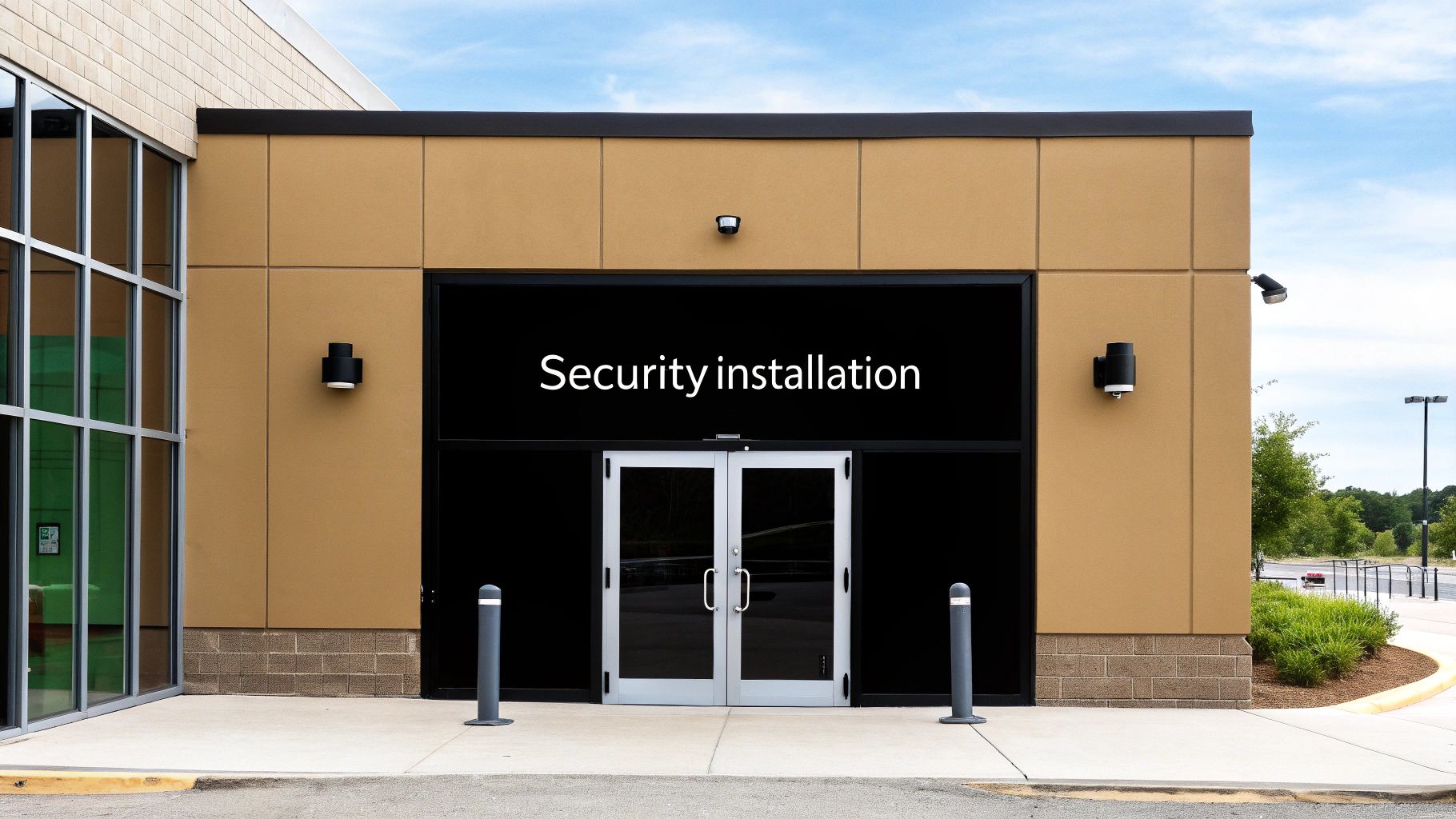A successful commercial security system installation isn’t about just mounting a few cameras. It’s a strategic process that starts long before any hardware is unboxed. The real work happens in the planning phase—assessing your risks, defining your goals, and creating a detailed blueprint. This is what ensures your investment actually protects your business where it’s most vulnerable.
Your Foundation For a Secure Business
Before a single wire is pulled, the success of your entire security system is decided by how well you plan. This isn’t just about picking out the latest gadgets; it’s about building a defense that’s specifically designed for your property and the threats it faces. If you rush this part, you’re essentially building a house without a blueprint—it’s guaranteed to have major flaws.
This kind of proactive planning is becoming the norm. The global market for commercial security systems is expected to jump from USD 222.86 billion in 2025 to USD 381.66 billion by 2030. That massive growth tells you one thing: businesses are waking up to the critical need to safeguard their people and their property.
Conducting a Realistic Security Audit
Your first real step is to walk your property with a critical eye. A thorough security audit helps you spot weak points you might otherwise miss. Don’t just glance at the front door and call it a day. You need to examine every possible entry point and vulnerability.
Grab a notepad and start a checklist as you do a physical walkthrough:
- Perimeter Access: Look at your parking lots, back alleys, and any outdoor storage areas. Are they well-lit? Are they monitored? Unsecured perimeters are often the first place trouble starts.
- Entry Points: Check every single door and window, including those on upper floors or in areas with low foot traffic. Are the locks strong? Do the frames need to be reinforced?
- Internal Blind Spots: Walk the interior and look for areas with no clear line of sight. Think hallways, stairwells, and hidden corners in your warehouse or stockroom.
- High-Value Zones: Where are your most critical assets? Pinpoint the locations of server rooms, cash offices, high-value inventory, or rooms with sensitive documents. These spots need specialized protection.
When you’re done, you’ll have a tangible map of your vulnerabilities. This turns vague security worries into a concrete to-do list.
Defining Your Security Goals
Once you know where your weaknesses are, you can decide what you need your security system to accomplish. Your goals have to be specific to your business operations, not just generic ideas like “improving security.”
A security system’s job goes far beyond just catching a burglar on camera. It’s about creating a genuinely safe environment, actively deterring threats before they happen, and even giving you operational insights that can help your business run better.
A retail store, for instance, might be focused on reducing shoplifting and watching for suspicious transactions at the register. A manufacturing plant, on the other hand, might need to monitor heavy machinery for safety compliance and strictly control who can access areas with hazardous materials. Understanding the full benefits of installing security features helps solidify why this foundational work is so important.
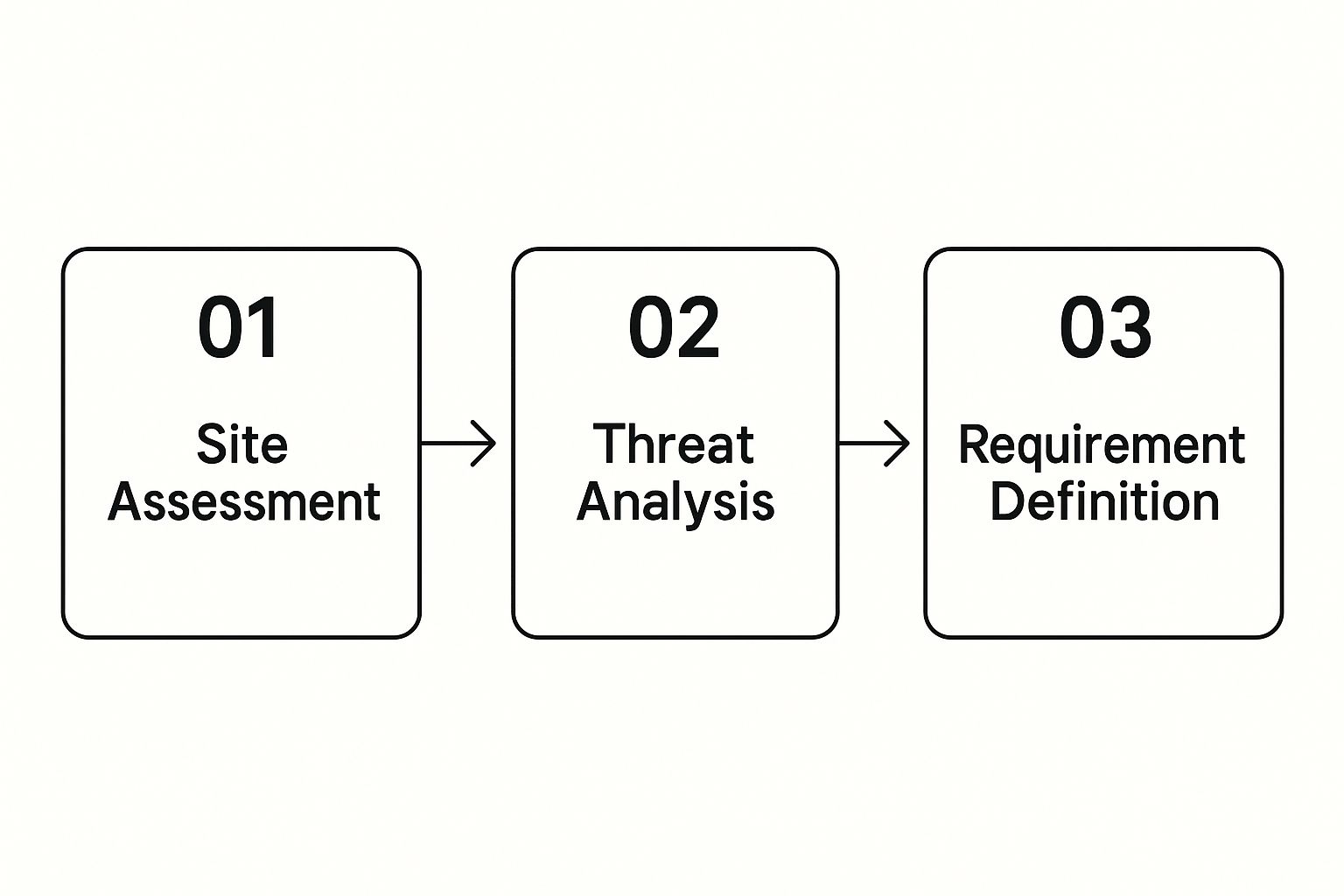
As you can see, a proper threat analysis directly informs what security components you’ll actually need. This ensures you don’t waste money on features you won’t use or, even worse, overlook something critical.
To help clarify what you might need, let’s break down the common components and what they do.
Security System Components and Their Primary Functions
This table outlines the essential pieces of a modern security system, helping you match the right technology to your specific goals.
| Component Type | Primary Function | Best For (Business Type) |
|---|---|---|
| CCTV Cameras | Visual surveillance, recording events, deterring crime. | Retail, Warehouses, Offices, Hospitality |
| Access Control | Restricting entry to authorized personnel via keycards, fobs, or biometrics. | Offices, Labs, Data Centers, Healthcare |
| Intrusion Alarms | Detecting unauthorized entry with door/window sensors and motion detectors. | All business types, especially after hours. |
| Environmental Sensors | Monitoring for floods, extreme temperatures, or smoke/CO. | Data Centers, Restaurants, Facilities with critical infrastructure. |
| Intercom Systems | Two-way communication and remote door release for visitor management. | Multi-tenant buildings, schools, gated facilities. |
Understanding these basic building blocks is key to having an intelligent conversation with a security provider and making sure the final system aligns perfectly with your audit and goals.
Creating a Practical Budget
With your vulnerabilities identified and your goals set, you can finally put together a realistic budget. One of the biggest mistakes I see businesses make is only budgeting for the initial cost of the hardware. To avoid surprise expenses down the road, a truly comprehensive budget needs to cover several key areas.
Make sure your budget has line items for:
- Equipment: The cameras, sensors, access control readers, and central panels.
- Professional Installation: The labor costs for all wiring, mounting, and system configuration.
- Monitoring Services: The monthly or annual fees for a professional team to monitor your alarms.
- Maintenance and Upgrades: A fund set aside for future repairs, essential software updates, and system expansion.
Thinking about these ongoing costs from the start is what turns your security system into a reliable, long-term asset instead of an outdated liability. This kind of planning elevates your installation from a one-time purchase to a smart, strategic investment in your company’s future.
Choosing the Right Security Technology
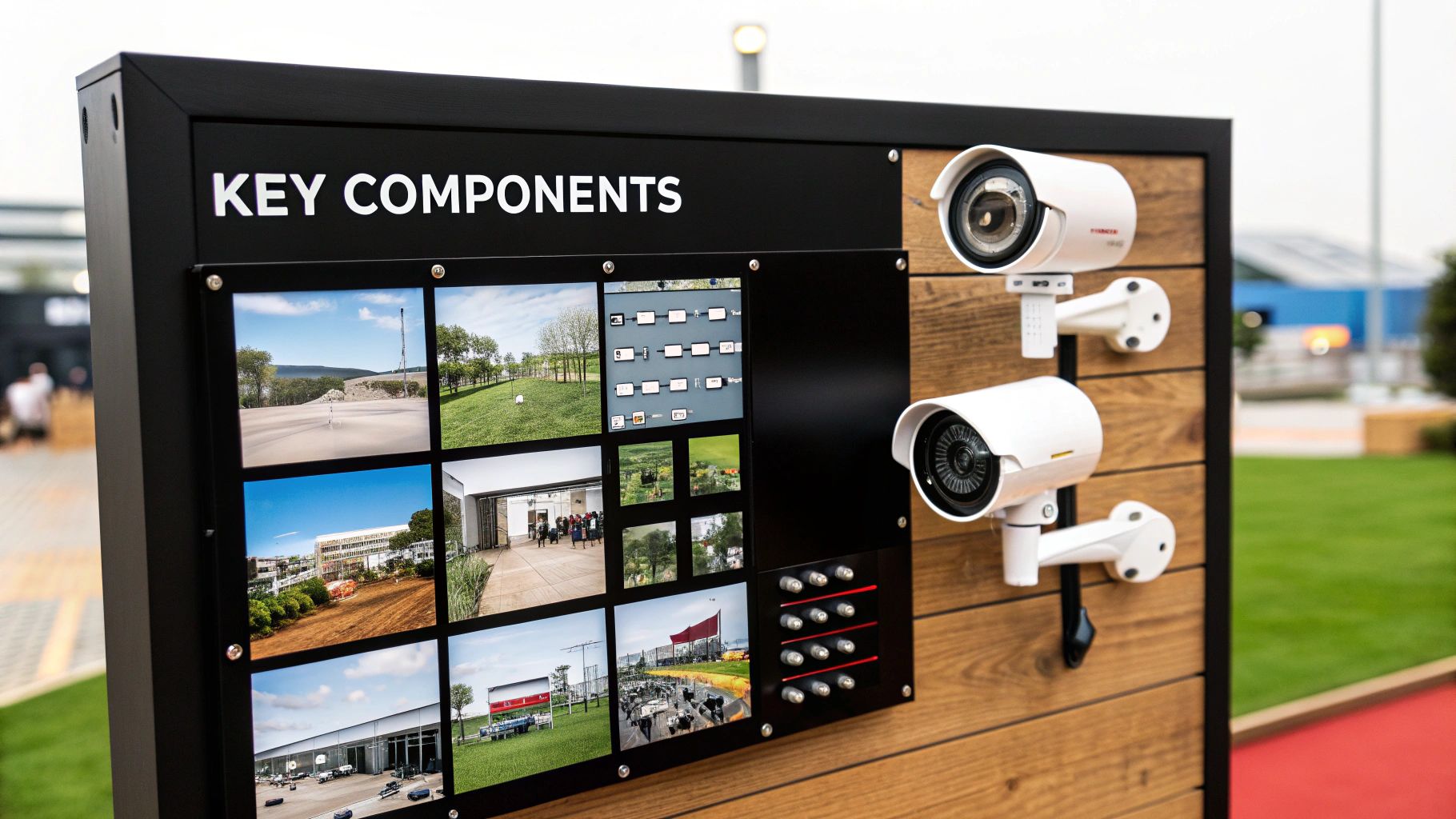
Once you’ve pinpointed your property’s weak spots, it’s time to talk hardware. This isn’t about buying the most expensive gadgets; it’s about choosing the right tools for the job. The hardware you select is the backbone of your entire security system.
Let’s cut through the jargon and get straight to what works. A successful commercial security system installation comes down to one thing: how well your technology solves your specific problems.
Cameras: Analog vs. IP Systems
Cameras are usually the first thing people think of, and for good reason. Your main decision here is between older analog systems and modern Internet Protocol (IP) cameras. While you can still find analog setups, IP systems are now the industry standard, and it’s not hard to see why.
- Analog Cameras: These are the old guard. They send video through a coaxial cable to a Digital Video Recorder (DVR). They’re cheaper upfront, but you get what you pay for—lower resolution and a real headache to expand. Adding a new camera usually means running a whole new cable back to the DVR.
- IP Cameras: These are digital cameras that run on a computer network, connecting to a Network Video Recorder (NVR). They deliver crisp, high-resolution video (HD, 4K, and up) and are incredibly flexible. You can add a camera anywhere you have a network connection, opening the door to advanced features like remote viewing and smart video analytics.
For a retail store that needs to capture clear faces or license plates, the high resolution from an IP camera is a must-have. A small back office just monitoring general movement might not need 4K, but investing in an IP system is the smartest move for future growth.
Access Control: Where It Matters Most
Cameras show you what happened, but access control stops things from happening in the first place. These systems are your digital gatekeepers, and the tech you choose should directly correspond to how sensitive an area is. Be prepared for a wide cost range, from $1,500 to over $10,000 per door, depending on the hardware.
Here are the most common options I see in the field:
- Key Cards and Fobs: The workhorse of access control. They are reliable and affordable for managing employee access to main entrances and general office areas.
- PIN Pads: A simple keypad is another popular choice. I often recommend pairing it with a key card for two-factor authentication, which adds a solid layer of security.
- Biometric Scanners: This is the top tier. Systems using fingerprints, facial scans, or even retinal patterns offer the best security because a credential can’t be lost, stolen, or shared.
Real-World Scenario: A 24-hour gym might just use key fobs for members to get in after hours. That’s perfectly adequate. But a law firm protecting a file room full of sensitive documents? I’d push them toward biometric fingerprint scanners to ensure only specific partners can ever get inside. The technology has to match the risk.
Alarms and Sensors: Seeing Beyond Intrusion
A truly solid security plan looks beyond just break-ins. The right sensors can warn you about a whole host of threats, protecting your inventory from damage and your people from harm. Your initial security audit should be your guide here.
Think of these sensors as your system’s nerve endings, constantly on alert for specific triggers.
Key Sensor Types for Businesses
| Sensor Type | Primary Function | Ideal for… |
|---|---|---|
| Motion Detectors | Triggers an alarm when it senses movement in a secured area. | Warehouses, offices, and retail stores after closing. |
| Glass-Break Sensors | Listens for the specific sound frequency of shattering glass for an early alert. | Businesses with large storefronts or glass-heavy designs. |
| Environmental Monitors | Senses dangerous shifts in temperature, humidity, or the presence of water. | Server rooms, restaurant freezers, and any facility with critical infrastructure. |
By layering these technologies, you build a much stronger defense. A warehouse, for instance, needs more than cameras. It needs powerful perimeter alarms for its huge open spaces, strict access control at loading bays to track every entry, and motion detectors to catch anyone moving around after hours.
We dive deeper into how all these pieces fit together in our guide to commercial building security systems. Choosing the right mix is how you invest wisely and build a system that actually protects your business from all angles.
What to Expect During a Professional Installation
This is where all the planning pays off. Your security blueprint is about to become a tangible, functioning shield for your business. A true commercial security systems installation is a meticulous process handled by trained technicians, not just a quick job. Knowing what to expect helps you manage the process and ensures you get the robust system you invested in.
It doesn’t start with drills and a box of cameras. The first step is actually a final check of the plan we’ve already built together.
The Initial Site Walkthrough and System Mapping
Before a single wire is pulled, the lead installation technician will walk the site with you or your designated contact. This isn’t a do-over of the initial audit; it’s a practical, real-world confirmation of the system design you approved.
The team’s goal here is to physically map out the exact placement for every single component.
- Camera Mounting Locations: They’ll confirm that the proposed camera spots offer clear, unobstructed views and deliver the coverage angles we need, without accidentally creating new blind spots.
- Sensor Placement: This is about checking that door and window sensors fit correctly and that motion detectors cover the right zones without being triggered by HVAC vents or heavy machinery.
- Wiring Pathways: They’ll identify the cleanest and most secure routes for running cables. The aim is to conceal them wherever possible to prevent easy tampering.
- Control Panel and NVR Location: We’ll finalize a secure, climate-controlled, and accessible spot for the brains of your system, usually in a locked IT closet or a back office.
This is your last chance to spot any potential snags before the physical work starts. A good installer will always welcome your questions and double-check every detail.
The Art of Clean and Secure Wiring
How the system is wired is just as important as the quality of the hardware. Sloppy, exposed wiring isn’t just an eyesore—it’s a massive security vulnerability.
Professional installers are experts in what’s called “wire fishing,” a technique for running cables through walls, ceilings, and conduits to keep them completely hidden and protected.
A professional installation prioritizes clean, hidden cabling. Exposed wires can be easily cut by an intruder, disabling cameras or sensors before they can even trigger an alert. The goal is to make the system’s infrastructure virtually invisible and inaccessible.
This painstaking work is what prevents tampering and ensures the system’s reliability for years to come. It’s one of the biggest differentiators between a DIY setup and a truly professional-grade installation.
System Configuration and Component Integration
Once the hardware is mounted and wired, the technicians shift to the configuration phase. This is where individual components are programmed to talk to each other and operate as a single, cohesive system.
This isn’t just about turning things on. The techs will be busy with crucial settings.
- Dialing in Camera Parameters: This involves adjusting focus, setting the right motion detection sensitivity, and programming recording schedules for each camera.
- Programming the Control Panel: The central hub gets set up, user codes are created, and the protocols for what happens when an alarm is triggered are defined.
- Integrating Access Control: If your system includes it, access readers are linked to the network. Technicians will test integrations to ensure, for example, that a forced door automatically triggers the nearest camera to start recording high-priority footage.
This focus on seamless integration is the hallmark of a system that delivers real value. It’s what’s driving the entire industry, with some projections showing the global commercial security market could rocket past $799 billion by 2035. This growth is fueled by businesses demanding exactly these kinds of interconnected technologies. You can find more on the strategic future of commercial security on marketresearch.com.
The Final Walkthrough and Handover
The installation wraps up with a comprehensive final walkthrough. This is your personal training session. The lead technician will demonstrate how to use every part of your new system, and you should feel completely comfortable with the basics before they pack up their tools.
Make sure they walk you through these key functions:
- Arming and disarming the main alarm system.
- Viewing both live and recorded video footage.
- Managing user access codes and permissions.
- Understanding system notifications and what different alerts mean.
They’ll also hand over all the necessary documentation, like user manuals and contact info for support. This handover is critical—it ensures you’re not just left with new hardware, but with the knowledge and confidence to protect your business from day one.
Integrating Security Into Your Daily Operations
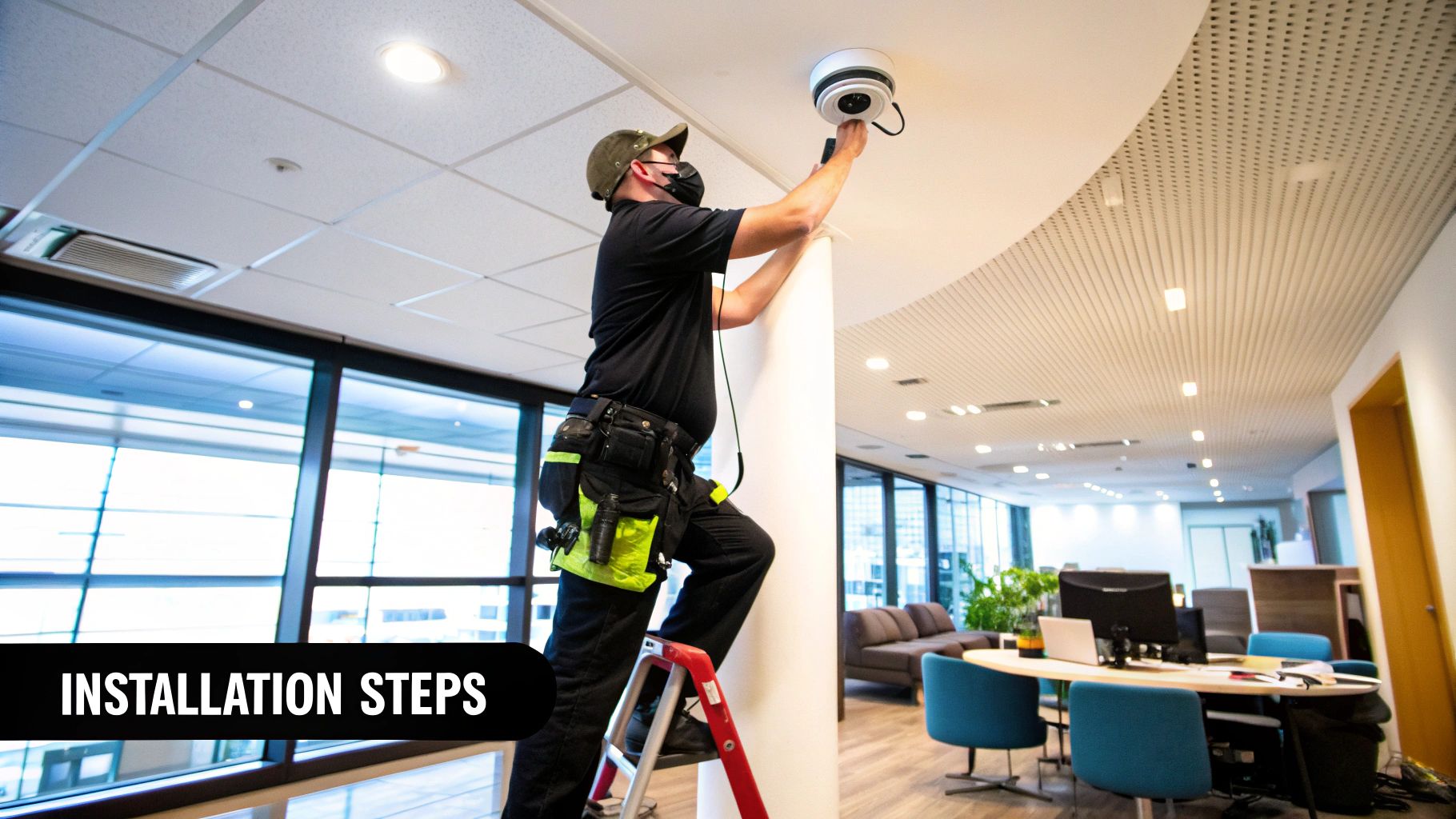
A great security system shouldn’t feel like a hurdle in your workday. On the contrary, it should weave itself into your daily operations so seamlessly that it becomes a tool for smarter, safer business. A successful commercial security system installation is one your team uses confidently without it ever getting in the way of their actual jobs.
The real goal here is to make your new system a strategic asset. This goes beyond just having cameras and alarms; it’s about solid employee training, crystal-clear emergency plans, and tapping into the system’s data to make better business decisions.
Empowering Your Team with Effective Training
The most sophisticated system on the market is practically worthless if your staff can’t use it properly. I’ve seen it time and again—user error is one of the biggest vulnerabilities, but it’s also one of the easiest to fix with the right kind of training.
Not everyone needs to be a superuser. The key is to tailor the training to what each person actually needs to know to do their job securely and efficiently.
Example Training Tiers:
- General Staff: Keep it simple. Focus on the essentials: how to use their access card, how to arm and disarm the alarm for their area, and who to call if something seems off.
- Managers & Supervisors: They need a bit more. Teach them how to pull up video footage after an incident, manage access for their direct reports, and understand what different system alerts mean.
- System Administrators: These are your experts. They need the full rundown—how to manage all user credentials, run system-wide reports, and be the main point of contact for your security partner.
This tiered approach gives everyone the right amount of knowledge without bogging them down with features they’ll never use.
Developing Clear and Actionable Response Protocols
When an alarm goes off, chaos is the enemy. Every second counts, so your team needs a clear plan they can execute without a second thought. This is where documented, easy-to-understand response protocols are non-negotiable.
Create straightforward action plans for different scenarios. Post them, practice them, and make sure everyone knows where to find them.
A well-defined response protocol turns panic into procedure. It provides your team with a clear roadmap for handling stressful events like a break-in, fire alarm, or medical emergency, ensuring decisive and correct actions are taken immediately.
For example, a protocol for an after-hours break-in alarm should spell out exactly who gets the alert, the first steps to verify the alarm (like checking cameras remotely), and the precise procedure for contacting law enforcement. No guesswork involved.
Moving Beyond Security to Business Intelligence
Today’s security systems are data goldmines. The information they gather offers powerful insights that can help you run your entire operation more effectively. This is where you start to see a real return on your investment, far beyond just loss prevention.
Think of your system as a silent partner in improving your business.
- Video Analytics: Modern cameras can do so much more than just record. I’ve seen clients use heat maps to see which parts of their retail store get the most foot traffic, helping them optimize product displays. People-counting features can pinpoint your busiest hours, making staff scheduling a breeze.
- Access Control Logs: An access log isn’t just for security. It can be used to verify employee time and attendance, doing away with manual punch clocks. It also creates an invaluable, auditable record of who went into sensitive areas and when, which is critical for compliance and any internal investigations.
This dual-purpose functionality is where the industry is moving. New technologies are constantly finding ways to boost operational efficiency while reducing the need for hands-on management. It’s no surprise that the Asia Pacific region is leading the world in adopting these systems, making advanced commercial security system installation a major focus for the next decade. You can explore more research on commercial security market trends to get a feel for what’s coming.
When you start using this data, your security system transforms from a necessary expense into a strategic asset that actually helps you grow.
Long-Term System Maintenance and Upgrades
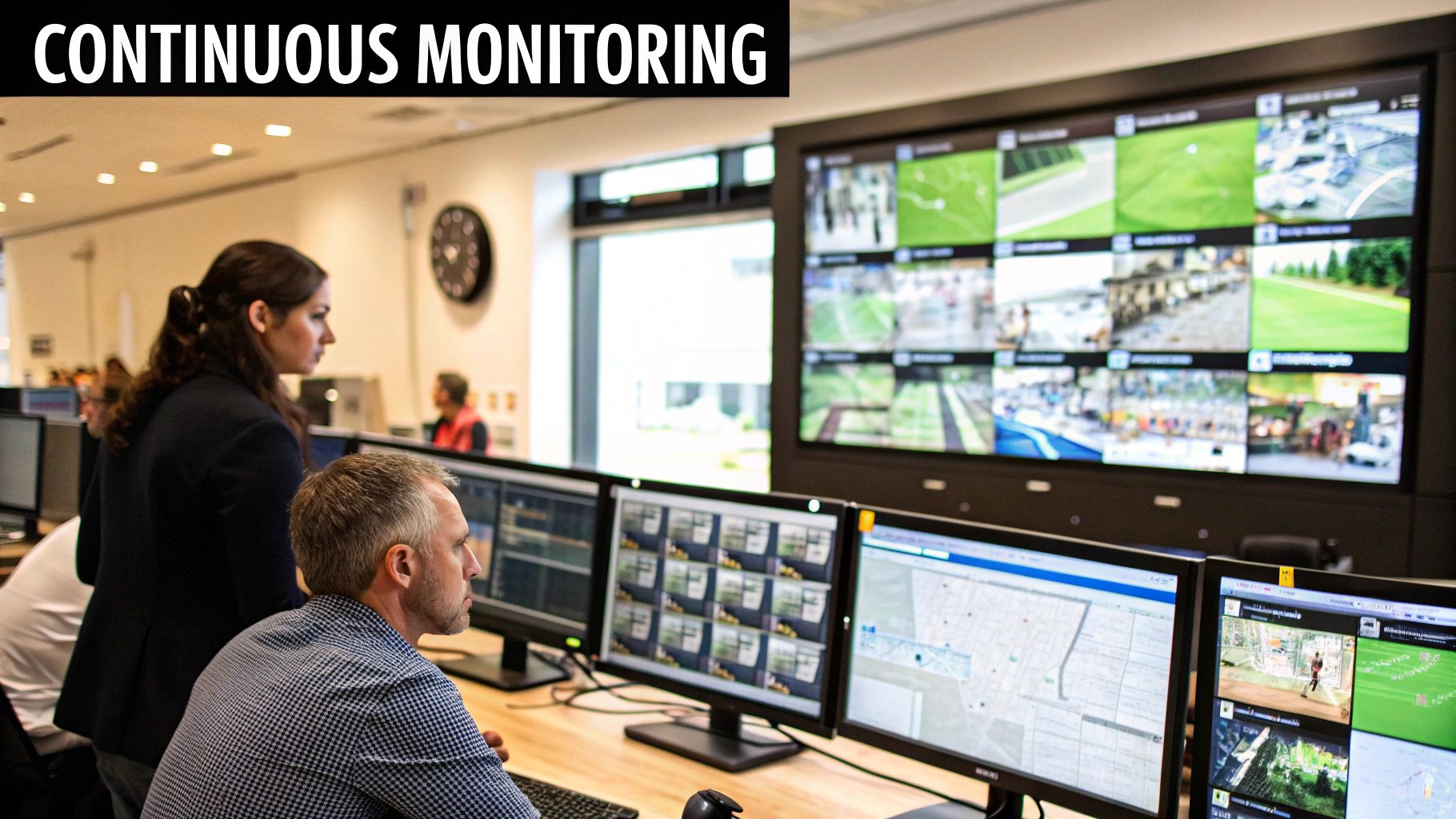
Once your installation team packs up and leaves, the real work begins. A successful commercial security system installation isn’t a one-and-done deal; it’s a long-term commitment. Proactive maintenance is the critical difference between a system that works flawlessly for years and one that fails right when you need it most.
Think of it like a company vehicle. You wouldn’t just drive it off the lot and expect it to run forever without oil changes or tire rotations. Your security system is the same—it needs consistent attention to ensure it’s ready to perform at a moment’s notice.
Establishing a Regular Maintenance Schedule
The best way to stay on top of maintenance is to be systematic. A simple schedule takes the guesswork out of the equation and prevents crucial checks from slipping through the cracks. This should be a living document that outlines routine tasks on a weekly, monthly, and quarterly basis.
Many businesses opt for a professional maintenance contract, which can range from $500 to $2,000 annually depending on the system’s size and complexity. Even with a service plan, your own team can—and should—perform simple visual checks to spot obvious problems early.
Your security system is a dynamic asset, not a static fixture. Regular maintenance isn’t just about fixing what’s broken; it’s about preventing failures before they happen, ensuring every component is ready to perform its duty at a moment’s notice.
To give you a practical starting point, here’s a sample maintenance schedule you can adapt for your own business.
Commercial Security Maintenance Checklist
| Frequency | Maintenance Task | Reason |
|---|---|---|
| Weekly | Visual Camera Check | Quickly spot if cameras have been tampered with, are obstructed, or have gone offline. |
| Monthly | Clean Camera Lenses | Dust, pollen, and grime can obscure a camera’s view, degrading image quality significantly. |
| Monthly | Test Sensor Functionality | Manually trigger motion and door sensors to confirm they send alerts to the control panel correctly. |
| Quarterly | Verify Video Storage | Check that footage is being recorded, stored properly, and is accessible for playback. |
| Annually | Inspect Wiring and Connections | Look for any frayed or exposed cables that could lead to system failure or create a vulnerability. |
| Annually | Test Backup Batteries | Ensure the uninterruptible power supply (UPS) for your NVR and panel works during a power outage. |
Keeping your system in peak condition involves more than just physical upkeep.
The Critical Role of Software and Firmware Updates
The hardware is the body, but the software is the brain. Just like your phone or computer, your security system’s software and firmware need regular updates. This is non-negotiable for two huge reasons.
First, updates patch security vulnerabilities that clever intruders could otherwise exploit. Second, they often add new features, fix bugs, and improve overall system performance. Skipping updates is like leaving your digital front door wide open.
Knowing When to Repair vs. When to Upgrade
Eventually, parts will wear out. The trick is knowing when a quick fix is enough and when it’s time for a full-blown upgrade.
- Repair It: If a single camera goes offline or one door sensor acts up, it’s usually an isolated problem. Replacing that one component is the most cost-effective solution, especially if the rest of your system is running smoothly.
- Upgrade It: Start thinking about an upgrade when you see the same problems popping up across multiple devices, when replacement parts are hard to find, or when your system can no longer support modern tech like high-resolution cameras or AI analytics.
Planning for future upgrades is just smart business. To learn more about getting the right foundation from day one, you can explore our complete guide on the best security systems for businesses.
Planning for Future Scalability
Your business is going to change, and your security system needs to be ready for it. One of the costliest mistakes I see is businesses installing a system that’s completely maxed out on day one. When it’s time to expand, they’re stuck with a “rip-and-replace” project, which is both expensive and disruptive.
Talk about scalability with your provider from the very beginning. Make sure the NVR has extra channels for future cameras and that the main panel can handle more sensors. A scalable system might cost a little more upfront, but it gives you the flexibility to grow your security right alongside your business, saving you a fortune down the road.
Answering Your Top Installation Questions
When you’re ready to pull the trigger on a new commercial security system, a lot of practical questions naturally pop up. It’s one thing to decide what you need, but it’s another to understand how it all comes together. Let’s walk through the common concerns I hear from business owners, from timelines and costs to making old and new tech play nicely together.
First up, the big one: “How long is this going to take?” There’s no single answer, as it really boils down to the scale of your project. For a small boutique wanting a few cameras and a basic alarm, we could be in and out in a day. But for a sprawling warehouse needing dozens of cameras, access control on every door, and integration with other systems, you could be looking at a week or more of careful work. The biggest time sinks are almost always the amount of cable we have to run and the sheer size of the building.
Then comes the money question: “What am I really paying for?” The hardware is just one piece of the puzzle. The final bill is heavily influenced by factors you might not see.
- The Building Itself: Running wires through a modern office with drop ceilings is straightforward. Doing the same thing in an older building with thick concrete or plaster walls? That’s a whole different ballgame and requires significantly more labor.
- System Integration: Getting your video cameras, door access, and alarm panel to talk to each other on one unified platform isn’t plug-and-play. It takes specialized software and configuration expertise, which has a cost.
- Custom Gear: If your site has unique needs—like thermal cameras to monitor server room temperatures or specific sensors for a cleanroom—that specialized hardware will naturally increase the budget.
This is exactly why a professional site survey is non-negotiable for getting a real, accurate quote.
Can I Mix My Old Security System with a New One?
This is a huge point of discussion, especially for businesses trying to upgrade on a budget. The short answer is, sometimes. It’s often possible to bring new IP cameras into an older analog system using devices called encoders. This can be a smart way to get high-definition video without ripping everything out and starting from scratch.
But—and this is a big but—compatibility can be a minefield. When you start mixing different brands and generations of technology, you risk creating functional gaps or a system that’s just plain unreliable.
While trying to salvage old equipment feels like saving money upfront, you have to weigh that against the long-term headaches. A fully integrated, modern system from a single, reputable provider will almost always be more reliable and easier to use than something cobbled together from different parts.
Before you go down this road, get an experienced technician to look at your current setup. They can give you an honest assessment of what can be reused and what’s likely to become a problem child down the line.
What’s the Deal with Professional Monitoring?
Many business owners get stuck here: “Should I monitor alerts myself or pay for a service?” Self-monitoring is when you get an alert on your phone, and it’s on you to figure out if it’s a real threat and call the police. It’s a decent option for smaller, low-risk businesses where the owner is always nearby.
Professional monitoring, which typically runs from $50 to over $300 a month, is a different league. Your system is connected to a 24/7 command center staffed by trained professionals. When an alarm goes off, an operator can often tap into your cameras to verify what’s happening before dispatching emergency services. This verification process drastically cuts down on false alarm fines and ensures a much faster response when every second counts. For most commercial properties, especially those with high-value inventory or that are empty overnight, it’s a critical layer of protection.
Ultimately, the best commercial security system installation is one where you’ve made informed choices every step of the way. When you understand the installation timeline, the real cost drivers, the risks of mixing old and new tech, and your monitoring options, you’re set up to get a system that truly protects your business and gives you real peace of mind.
Ready to build a security solution that protects your assets and enhances your operations? Clouddle Inc specializes in designing and installing integrated security systems tailored to your specific business needs. We handle everything from the initial site survey to long-term support, ensuring your system is reliable, scalable, and easy to manage.


